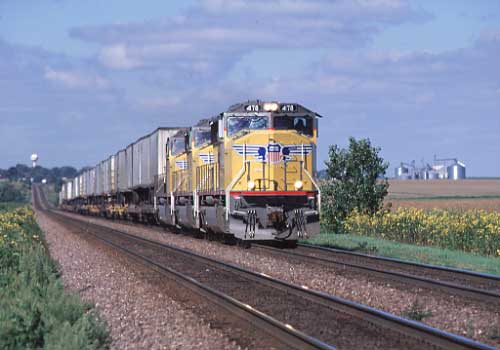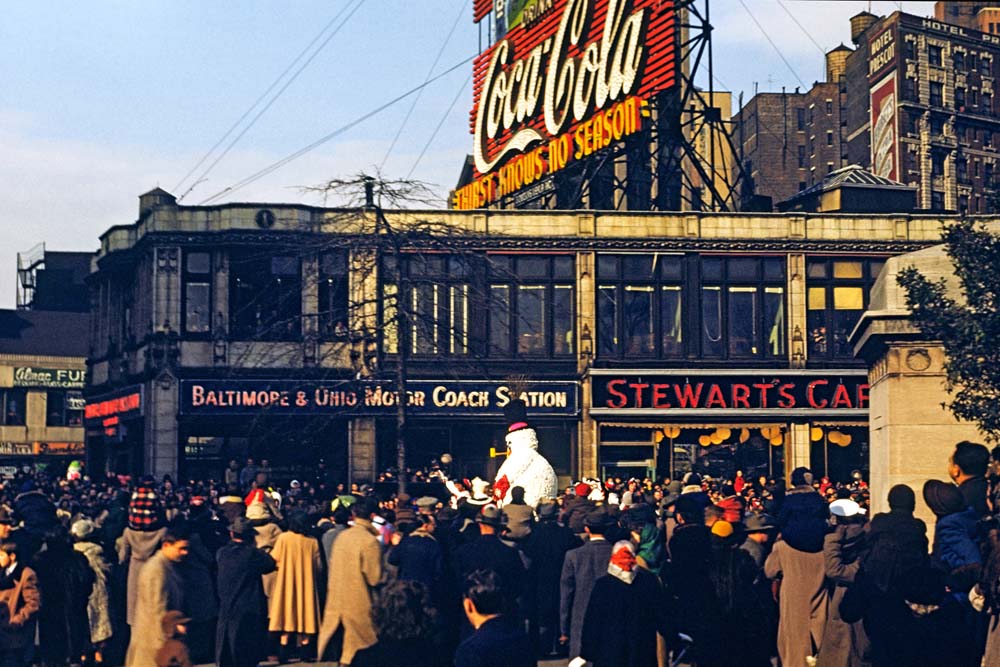UP began as the easterly link in the nation’s first transcontinental route from Omaha Nebr. to Promontory, Utah near Ogden, completed May 10, 1869. The railroad later added lines serving Kansas City, Denver, Los Angeles, Portland, Ore. and Seattle.
UP acquired the Western Pacific in 1981 and the Missouri Pacific in 1982, extending its system to San Francisco and throughout the south central states. In 1988, it added the Missouri-Kansas-Texas (“the Katy”), linking Kansas City with Houston and San Antonio.
On June 23, 1995, UP acquired the Chicago & North Western, long its link from Omaha to Chicago and Minneapolis. C&NW’s earliest predecessor dated from 1848. In the 1970’s, C&NW subsidiary Western Railroad Properties, Inc. (WRPI) began operating the lucrative Powder River coal line with competitor Burlington Northern.
On September 11, 1996, UP acquired Southern Pacific Lines, expanding its system by over 14,000 miles, and in the process, bringing the eastern and western halves of the nation’s first transcontinental railroad under common ownership. SP arced around the U.S.’s western and southern perimeter from Portland, Ore. to New Orleans, plus the line from Sacramento, Calif. to Ogden, Utah which was the Central Pacific portion of the transcontinental route.
Included in the acquisition were SP subsidiaries Denver & Rio Grande Western and St. Louis Southwestern (Cotton Belt), adding lines from Ogden to Denver, Kansas City, St. Louis and Chicago to the UP system.
Commodities
The most important commodities on Union Pacific are coal, intermodal trailers and containers, chemicals, and industrial products such as lumber and steel.
UP hauls coal out of Wyoming’s Powder River Basin destined for power plants located primarily in the Southwest and Midwest. Coal from Utah is transported to power plants in Utah and Wyoming and the ports of Los Angeles and Long Beach. Coal also originates from mines in Colorado and Illinois.
UP carries plastics, liquid petroleum, intermediate liquid chemicals, and related commodities out of the chemical producing region along the Gulf of Mexico, from New Orleans west through Houston to Corpus Christi, Texas. Fertilizer also moves from the Gulf Coast, as well as the western U.S. and Canada, to agricultural firms in the West and Midwest.
Unit trains of soda ash originate in Wyoming and California. One third moves west for export, while another third is transported to U.S. glass manufacturers.
Lumber originates from paper mills in the Pacific Northwest and South Central regions of the U.S.
Grain from the Midwest and West moves to domestic customers, Mexico, and ports on the Gulf Coast and in the Pacific Northwest. Corn and soybean grown in the Midwest contribute heavily to the railroad’s agricultural traffic base. Frozen meat and poultry is transported to the West Coast for export. Refrigerated boxcars of fruits, vegetables, and canned goods move in two expedited corridors: from California’s San Joaquin Valley to New York and Boston, and from the Pacific Northwest to Atlanta and Florida.
Two of Union Pacific’s largest customers are Pacer International and General Motors. Pacer stacktrains, begun by American President Lines in 1984, run daily between Chicago and terminals in Southern and Northern California. Another key UP intermodal corridor is Ogden, Utah to Portland, Ore., which sees both Pacer double-stack and UPS trailer trains. Automobiles manufactured at U.S. plants and imports received from Mexico and ports on the West Coast provide a steady stream of auto and auto parts traffic.
Some of the primary commodities on UP’s Portland – Los Angeles I-5 Corridor are southbound loads of lumber from Oregon and northbound loads of consumer products. This corridor also sees coal, potash, finished autos and lumber traveling to and from Canada.
From spokes at Portland, Oakland and Los Angeles, and the East Coast gateways of Chicago, Kansas City, and St. Louis, UP’s main lines join together in a trunk running across the western half of Nebraska.
UP’s triple-track main line between Gibbon and North Platte is the busiest freight railroad in the U.S., with more than 120 trains a day. At North Platte lies Bailey Yard, the largest classification yard in the world.
Headquarters:
Union Pacific Railroad
1416 Dodge Street
Omaha, NE 68179
(402) 271-5000
www.uprr.com















These crossings are just chock full of wheel drops due to track wear to metal fatigue and erosion. I worked at a machine shop that made test samples for different steels used in RR track use. They are continually looking for a tougher steel. They can’t use heat treated tool steel ‘ the stuff will just break. At the angle these two line cross, erosion will always be a problem.
CAN ANYONE ENLIGHTN US AS TO WHAT WORKERS ARE DOING SEVERAL HOURS EVERY DAY
AT THE U.P. TRACKS
……..WHAT DICKENS THEY DOING ????
What is happening on the Diamond in Rochelle today?
hi I wish u p could bring a sd70m to oz to display on Australia railroads regards ash
Love the Rochelle webcam! and I live near the Thornton junction in South Holland IL, so i hear several trains/day on both the UP and CSX (ex-GTW) lines
EVERY DAY-EVERY DAY-EVERY DAY-
WORKERS ATTEND TO THE DIAMONST
SEEMS TO BE A ” BIG PROBLEM ” WITH PEOPLE THERE EVERY DAY WORKING ON THE DIAMOND.
CUROSITY KILLED THE CAT !
WHAT GOES ON – ANYONE KNOW “”??””
My HO Scale layout on the 8' x 14' tables does feature the magnificent Union Pacific freight trains…Love the American flags on their locomotives, from Dothan, AL.
Grew up in the Chicago area and watched the CN&W all the time, now its the UP out here in the West, got to see two great railroads at one time now.
Hello
I remember one Sunday morning I saw 12 trains in one hour!
ErieJoe.Found your web cam,Think it great.Live 2 blocks from BNSF. Hardly see a train,now got The web cam.
Maybe it was a tropicana juice train!
Just saw a UP train at Rochelle with fleet of white boxcars.
What's that all about?
Graffitti half way up!
doc steve
I love the webcam!
Fantastic action and a super webcam setup! Love this and watch everyday!
This Rochelle webcam is GREAT!!
I watch the Rochelle webcam. There is a lot of Union Pacific.
Union Pacific is a railfan friendly operation, and it does good business with excursion operators!